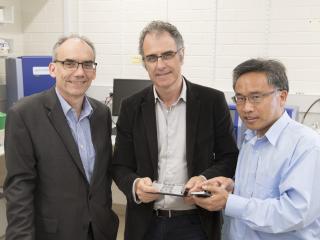Western Australia
April 27, 2017

Murdoch University Deputy Vice Chancellor (Research and Innovation), Professor David Morrison (left), DAFWA Executive Director Grains Research and Development Dr Mark Sweetingham and Western Barley Genetics Alliance director Dr Chengdao Li discuss the intricacies of the barley genome map
The development of new and improved barley varieties is set to be accelerated, after the complete barley genome was recently mapped by an international consortium, which included Western Australian scientists.
The Western Barley Genetics Alliance, a partnership between the Department of Agriculture and Food and Murdoch University, was a major contributor to the research, assisted by funds from the Grains Research and Development Corporation (GRDC).
Alliance Director, Murdoch University Professor Chengdao Li, said the WA-based group was among the elite group of international scientists who mapped two of the seven barley chromosomes.
Professor Li said the barley genome map pinpointed genetic information, from which molecular markers and genomic breeding tools could be developed to enhance future barley varieties.
“Mapping the barley genome effectively provides a ‘dictionary’ from which genetic ‘words’ and ‘sentences’ can be produced that identify the genes that control traits, such as yield, adaption to climate, quality and pest and disease tolerance,” he said.
Dr Li said the map was a great achievement, especially given its complexity.
“Cereal crops, including bread wheat, durum, barley and rye, have some of the most complex genetic histories among the world’s cultivated species,” he said.
“Barley is the first crop in this tribe to be sequenced in such detail. To put the research into perspective, the barley genome is twelve times larger than the rice genome and more complex.”
The alliance worked in partnership with scientists from 10 countries participating in the Barley Genome Sequence Consortium, including Germany, the United Kingdom, Australia, the United States, Finland, Denmark, China, the Czech Republic, Sweden and Switzerland.
“This research was so large and complex that no single country had the capacity to complete it so an international collaboration was essential,” Professor Li said.
“The consortium of scientists integrated next generation sequencing, chromosome conformation capture sequencing, nanotechnology and super-computing to map the barley genome and assemble the largest crop genome so far.”
Professor Li said the new barley genome map was underpinned by high-quality research standards.
“We have developed the ‘gold standard’ of genetic maps, resulting in greater precision and more detailed data, which will provide plant breeders and researchers with confidence to manipulate genes to develop the next generation of barley varieties,” he said.
In the interests of furthering global science, the consortium intends to make the barley genome information publically available.
Department Executive Director Grains Research and Development, Mark Sweetingham, applauded the alliance scientists for their contribution to industry productivity and profitability, as well as enhancing global food security.
“This ground-breaking research lays the foundations that will enable plant breeders to target and combine more favourable gene combinations to develop new high-performance barley varieties, tailored to local environments and markets,” Dr Sweetingham said.
“Using the reference genome sequence as a template, the alliance has also mapped the genomes of the key barley varieties Hindmarsh, La Trobe, Commander and Baudin, which will lay a solid foundation to develop new barley varieties.
“The department is already using this genetic information in a number of ways, such as addressing the issue of blue aleurone, a blue discolouration found intermittently in Litmus barley. Genome sequence information is also being used to improve variety identification through DNA fingerprinting.”
Murdoch University Deputy Vice Chancellor (Research and Innovation), David Morrison, said the work by the alliance epitomised successful solution-driven science, using the technical strengths across the two organisations.
“The genome sequencing project is a fine example of collaboration between Murdoch University and DAFWA to address a global problem by combining barley genetics from DAFWA and bioinformatics and super-computing from Murdoch University,” Professor Morrison said.
“The benefits of this research will be far reaching, from improving WA malt and feed barley production to assisting food production in developing countries.”
Further information can be found in the scientific paper on the barley genome map.